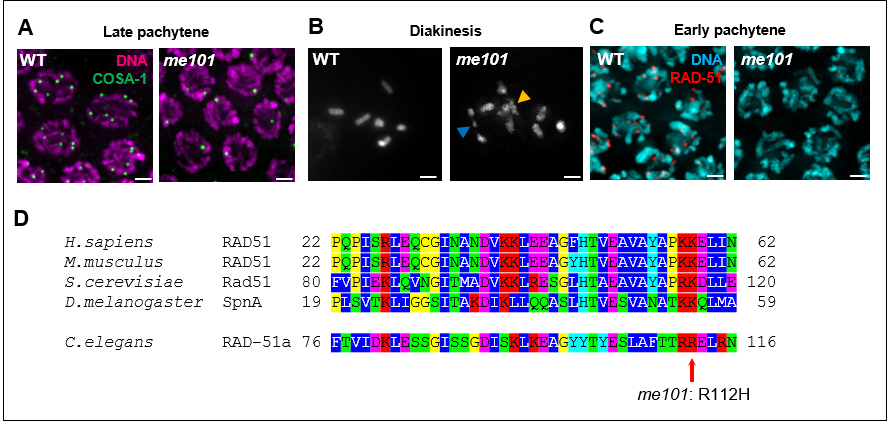Description
The me101 allele was isolated in a genetic screen for mutants with an altered number of GFP::COSA-1 foci, which mark the sites of crossovers in C. elegans germ cells (Rosu et al. 2013). After multiple rounds of outcrossing, we confirmed that me101 mutants were defective in some aspects of meiotic prophase, as late pachytene me101 mutant meiocytes failed to form the six GFP::COSA-1 foci observed in wild-type late pachytene meiocytes (Fig 1.A). We also observed structural defects ranging from chromosome fragmentation to the formation of chromosome aggregates in me101 diakinesis-stage oocytes (Fig. 1B), suggesting a defect in some aspect of the DNA damage response. Further, 100% of eggs laid by me101 mutant hermaphrodites are inviable. We then assessed the localization of the recombinase RAD-51, an essential component of the homologous recombination machinery that is required for the repair of DNA breaks and the maintenance of genome integrity during meiosis (Rinaldo et al. 2002; Alpi et al. 2003); no RAD-51 foci were observed in the gonads of me101 mutants (Fig 1C). Sequencing of the rad-51 locus in the me101 mutant revealed a single G to A substitution (IV:10283785 from WS269), leading to an Arginine to Histidine substitution in a conserved residue (Fig. 1D). Failure to detect RAD-51 foci in the me101 mutant indicates that this residue is important for the loading and/or the stability of the RAD-51 protein.
Methods
Request a detailed protocolCytology: Immunofluorescent detection of GFP::COSA-1 and RAD-51 was performed as described in (Martinez-Perez and Villeneuve 2005) using a mouse anti-GFP antibody (Sigma-Aldrich #11814460001) and a rabbit anti-RAD-51 antibody (Colaiacovo et al. 2003).
Reagents
Strains:
AV727 meIs8[pie-1p::gfp::cosa-1 + unc-119(+)] II ; ltIs37[pie-1p::mCherry::his-58 + unc-119(+)] IV ; ltIs38[pie-1p::gfp::ph(PLC1delta1) + unc-119(+)]
AV880 meIs8[pie-1p::gfp::cosa-1 + unc-119(+)] II ; rad-51(me101) ltIs37[pie-1p::mCherry::his-58 + unc-119(+)] / nT1[qIs51] IV ; +/nT1 V; ltIs38[pie-1p::gfp::ph(PLC1delta1) + unc-119(+)]
References
Funding
This work was supported by NIH grants R01GM067268 and R35GM126964 to AMV.
Reviewed By
Cori CahoonHistory
Received: April 11, 2019Accepted: May 24, 2019
Published: April 26, 2019
Copyright
© 2019 by the authors. This is an open-access article distributed under the terms of the Creative Commons Attribution 4.0 International (CC BY 4.0) License, which permits unrestricted use, distribution, and reproduction in any medium, provided the original author and source are credited.Citation
Roelens, B; Zawadzki, KA; Villeneuve, AM (2019). me101 is a new allele of rad-51. microPublication Biology. 10.17912/micropub.biology.000107.Download: RIS BibTeX




